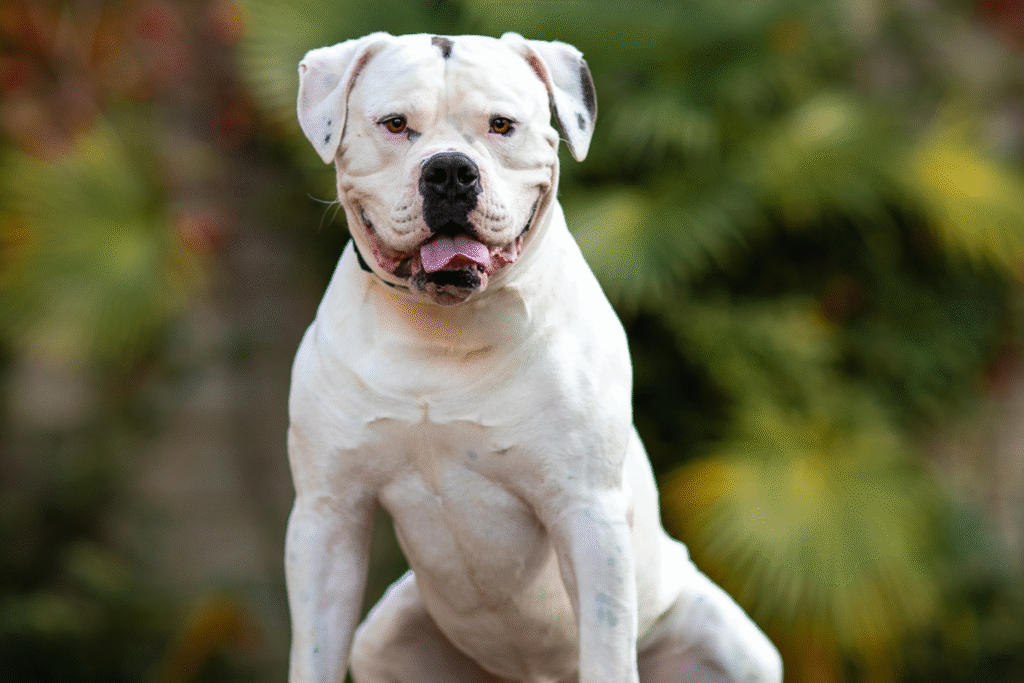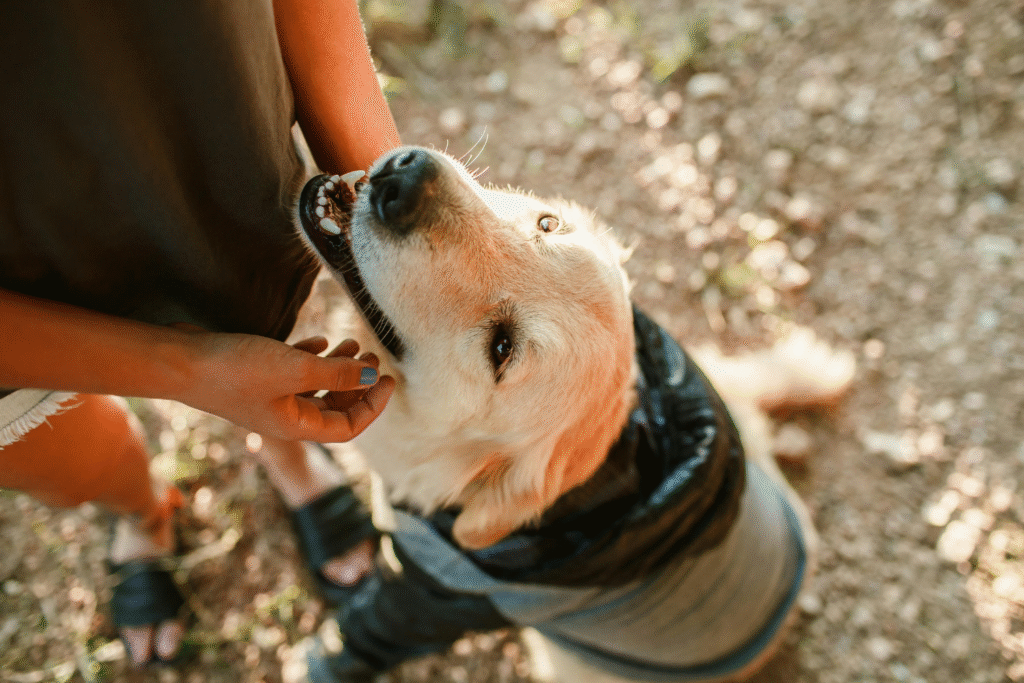Your sweet pup might be silently claiming territory.

Most dog owners think resource guarding looks like a snarling, snapping beast protecting a bone. But the reality is way more subtle and happens right under our noses every single day. While we’re busy thinking our dogs are just being quirky or cute, they’re actually displaying early warning signs of possessive behavior that could escalate into serious problems. These aren’t the dramatic scenes you see in dog training shows. Instead, they’re the small behaviors that seem harmless until you realize your dog has been systematically training you to stay away from their stuff. The scary part is that many of these subtle signs actually work in the dog’s favor, so the behavior gets reinforced without anyone realizing what’s happening. By the time most owners recognize resource guarding, it’s already become a deeply ingrained habit.
1. Body blocking happens when dogs position themselves strategically.

Watch your dog’s positioning around their food bowl, favorite toy, or sleeping spot. Dogs who are beginning to guard resources often place themselves between their valued item and approaching humans or other pets, even when no direct threat exists. According to research published by the Association of Professional Dog Trainers, body blocking is one of the earliest indicators of developing resource guarding behavior, often appearing weeks or months before any aggressive displays.
The behavior looks innocent enough that most owners don’t recognize it as a warning sign. Your dog might casually walk over and lie down between you and their food bowl, or step sideways to block your path to their favorite toy. This strategic positioning allows them to monitor and control access to their resources without appearing confrontational.
2. Eating speeds increase dramatically when people approach nearby.

Dogs who wolf down their food aren’t necessarily just hungry or excited about dinner time. Rapid eating often signals anxiety about food security, with dogs rushing to consume resources before someone can take them away. The behavior becomes especially pronounced when family members walk near the feeding area, even if they have no intention of interfering with the meal. Professional animal behaviorists report that eating speed changes represent one of the most reliable early predictors of food guarding behaviors, as reported by veterinary behaviorists studying canine resource protection patterns.
Many owners actually encourage this behavior by commenting on how “eager” their dog is to eat or how much they “love” their food. The rapid consumption continues because dogs learn that finishing quickly prevents any possibility of interruption. This creates a cycle where anxiety drives speed, and speed reinforces the dog’s belief that their food is under constant threat.
3. Stiffening occurs around valued items without obvious aggression.

Body tension is one of those blink-and-you-miss-it signals that reveals a dog’s emotional state around resources. A dog might freeze mid-chew when someone approaches, or their muscles might visibly tense while they’re holding a favorite toy. According to animal behavior specialists at the University of Pennsylvania School of Veterinary Medicine, this physical stiffening represents the dog’s internal conflict between wanting to protect their resource and not wanting to escalate the situation through overt aggression.
The stiffening usually lasts just a few seconds, making it easy for owners to miss or dismiss as normal behavior. But this momentary tension reveals that the dog is actively processing the approaching person as a potential threat to their resource. Without intervention, this internal stress often develops into more obvious guarding behaviors as the dog’s confidence in their ability to protect resources grows.
4. Hoarding behaviors start small and escalate gradually.

Your dog might begin collecting toys in their bed or under furniture, creating little treasure troves that seem adorable until you realize what’s actually happening. This gathering behavior represents the early stages of resource guarding, where dogs attempt to consolidate valuable items in locations they can easily defend. The hoarding often starts with one or two special toys before expanding to include more items.
Initially, dogs might simply prefer to keep their favorite things nearby while they rest. But the behavior evolves as dogs realize they can control access to multiple resources simultaneously by keeping them in one defendable location. Owners often unknowingly reinforce this by allowing the hoarding to continue or even helping their dog collect scattered toys.
5. Displacement activities increase when resources are present.

Dogs who suddenly start scratching, yawning, or licking their lips while near valued resources might be displaying stress signals rather than normal behaviors. These displacement activities help dogs cope with the anxiety of potentially losing something important to them. The behaviors often seem random and unrelated to the situation, making them easy to overlook.
Careful observation reveals that these stress signals consistently appear in resource-related contexts. A dog might start excessive scratching only when holding a bone, or begin compulsive yawning when people approach their food area. The displacement behaviors serve as pressure release valves for dogs who are feeling conflicted about their resources but haven’t yet escalated to more direct guarding strategies.
6. Following behavior intensifies around specific items.

Dogs who shadow their owners while carrying toys or bones are often monitoring human behavior for signs of resource threats. This following isn’t the normal companionship behavior that dogs display throughout the day. Instead, it’s hypervigilant monitoring that occurs specifically when the dog has something they consider valuable.
The dog might carry their prize around the house, stopping whenever their owner stops and watching for any signs of interest in their item. This behavior allows dogs to maintain possession of their resource while keeping close tabs on potential threats. Many owners find this shadowing behavior endearing without realizing it indicates their dog feels insecure about keeping their possessions.
7. Preference changes occur for previously neutral locations.

Dogs developing resource guarding often begin avoiding areas where they previously felt comfortable eating or playing. They might stop using their usual food bowl location and prefer eating in corners, under tables, or in other areas that provide better visual monitoring and escape routes. These location preferences seem practical from the dog’s perspective but indicate growing anxiety about resource security.
The changes usually happen gradually, with dogs first showing slight hesitation about their normal spots before completely abandoning them. Owners often accommodate these preferences by moving food bowls or allowing eating in new locations, inadvertently reinforcing the guarding behavior by providing the security the dog seeks.
8. Eye contact patterns shift during resource interactions.

Dogs who are developing guarding tendencies often change their eye contact behavior around valued resources. They might begin staring intensely at approaching family members, or conversely, they might avoid eye contact entirely while remaining hyperaware of human movements. Both patterns indicate that the dog is processing the human presence as potentially threatening to their resources.
The staring serves as an early warning system, allowing dogs to assess human intentions before deciding whether defensive action is necessary. Avoidance of eye contact, meanwhile, represents the dog’s attempt to reduce social pressure while maintaining possession of their resource. Either pattern suggests the dog is no longer relaxed and trusting around their valued items.
9. Vocalization changes become more frequent during resource handling.

Subtle vocal changes often precede more obvious resource guarding displays. Dogs might begin making low whining sounds, soft growls, or unusual huffing noises while eating or playing with toys. These vocalizations serve as early warning signals, communicating the dog’s discomfort with the situation while still maintaining plausible deniability about aggressive intent.
Owners frequently miss these vocal cues because they’re often quiet and brief. The sounds might seem like normal contentment noises or excitement rather than stress signals. But consistent vocalization patterns around resources indicate that the dog is feeling pressure about maintaining possession of their valued items.
10. Recovery time increases after resource interactions end.

Dogs who are stressed about resource security often need longer periods to relax after resource-related encounters. They might remain tense and hypervigilant for several minutes after finishing a meal or after someone has walked past their toy area. This extended arousal period indicates that the dog’s nervous system is processing these interactions as stressful events.
Normal dogs typically return to baseline relaxation levels within moments of finishing resource-related activities. Extended recovery periods suggest that the dog is experiencing ongoing anxiety about their resources and spending mental energy monitoring for future threats. This chronic stress often leads to the development of more obvious guarding behaviors as the dog’s tolerance for resource-related interactions decreases over time.
